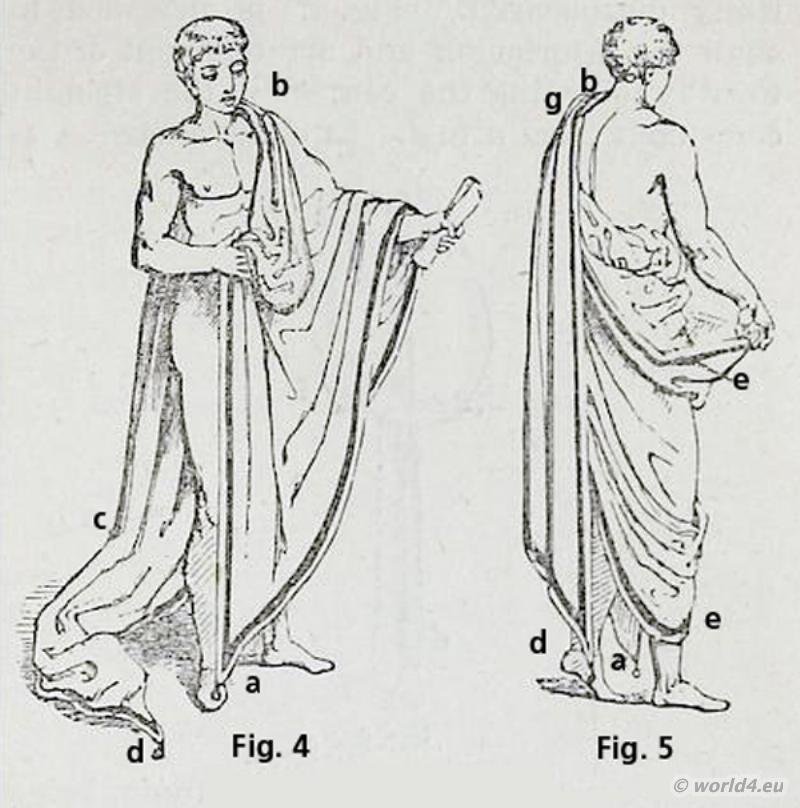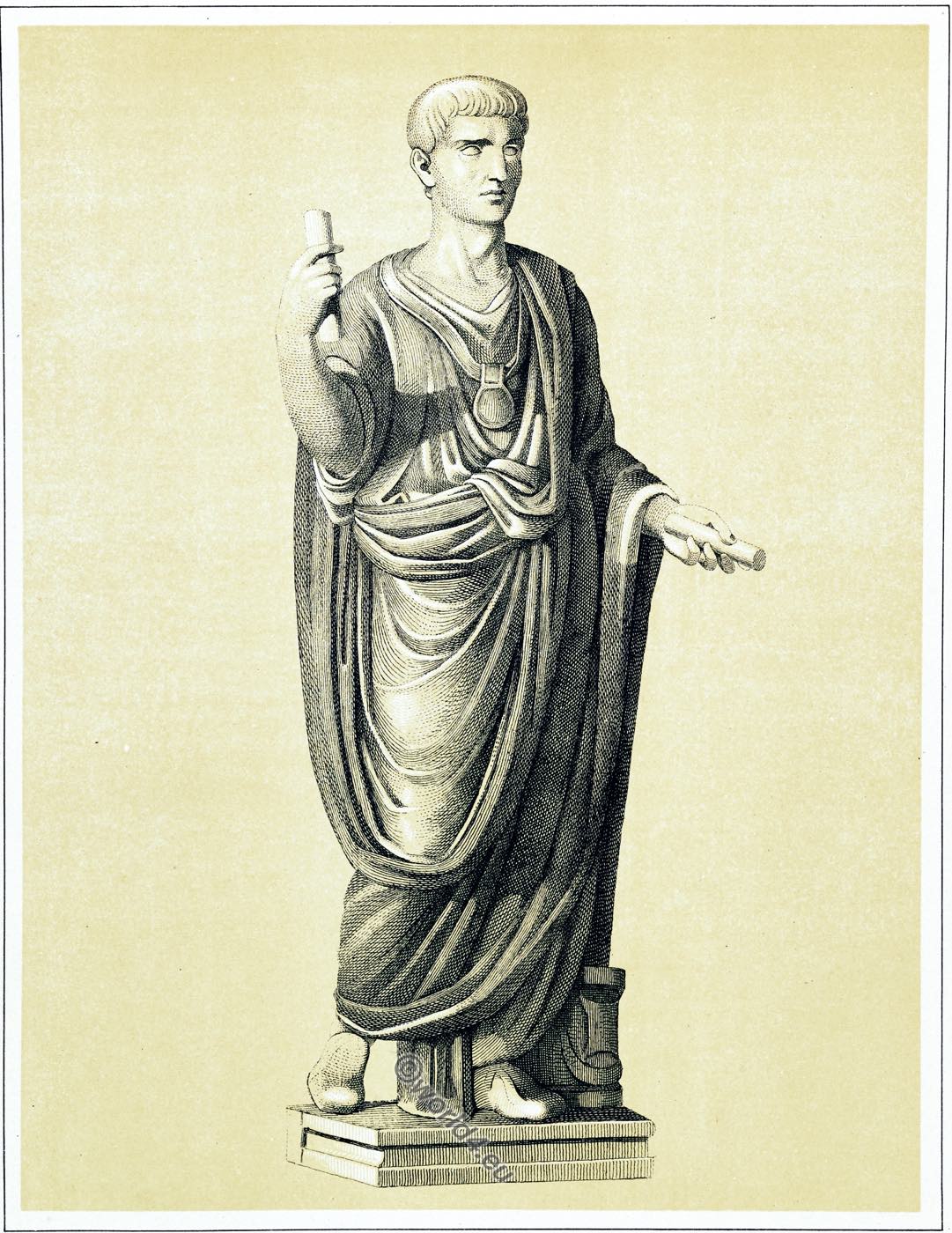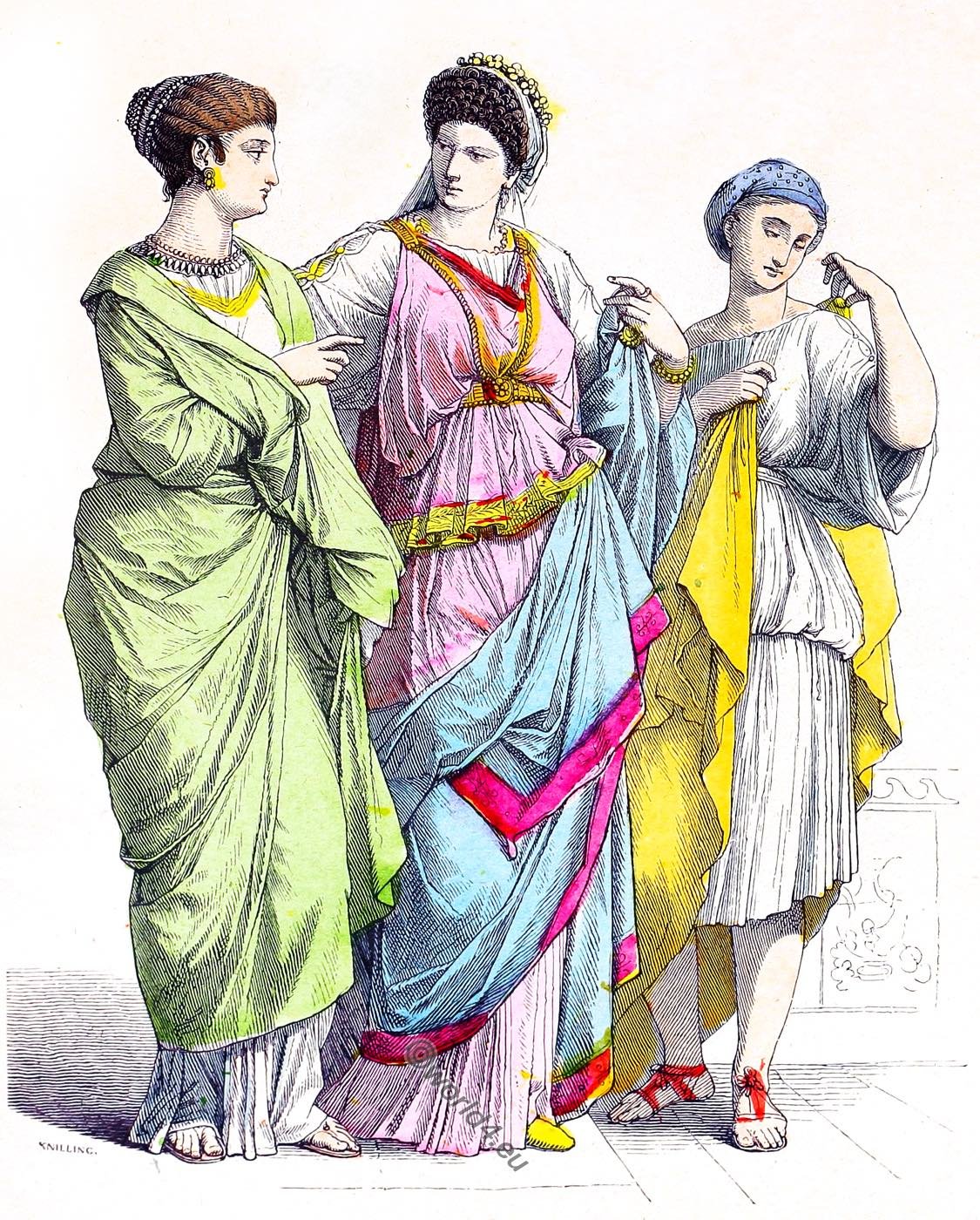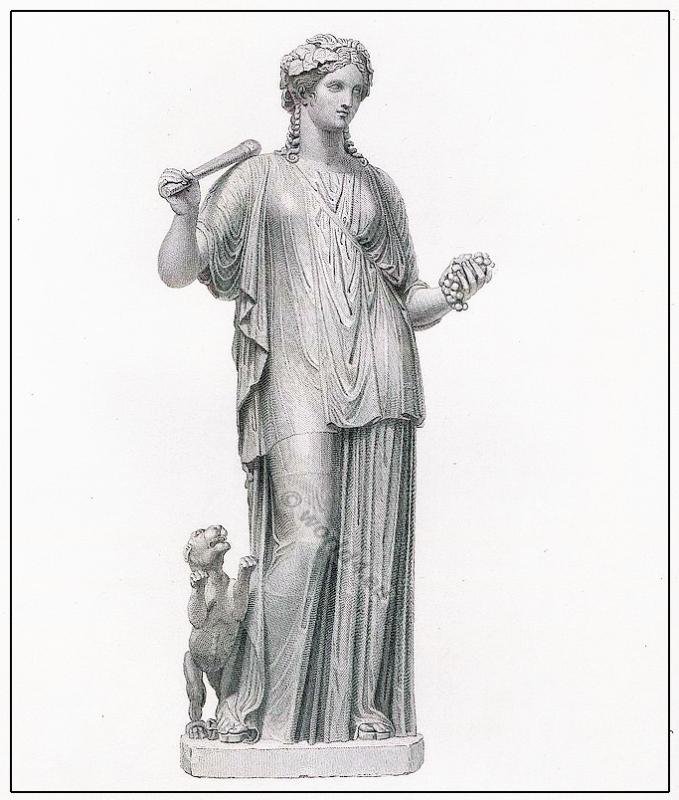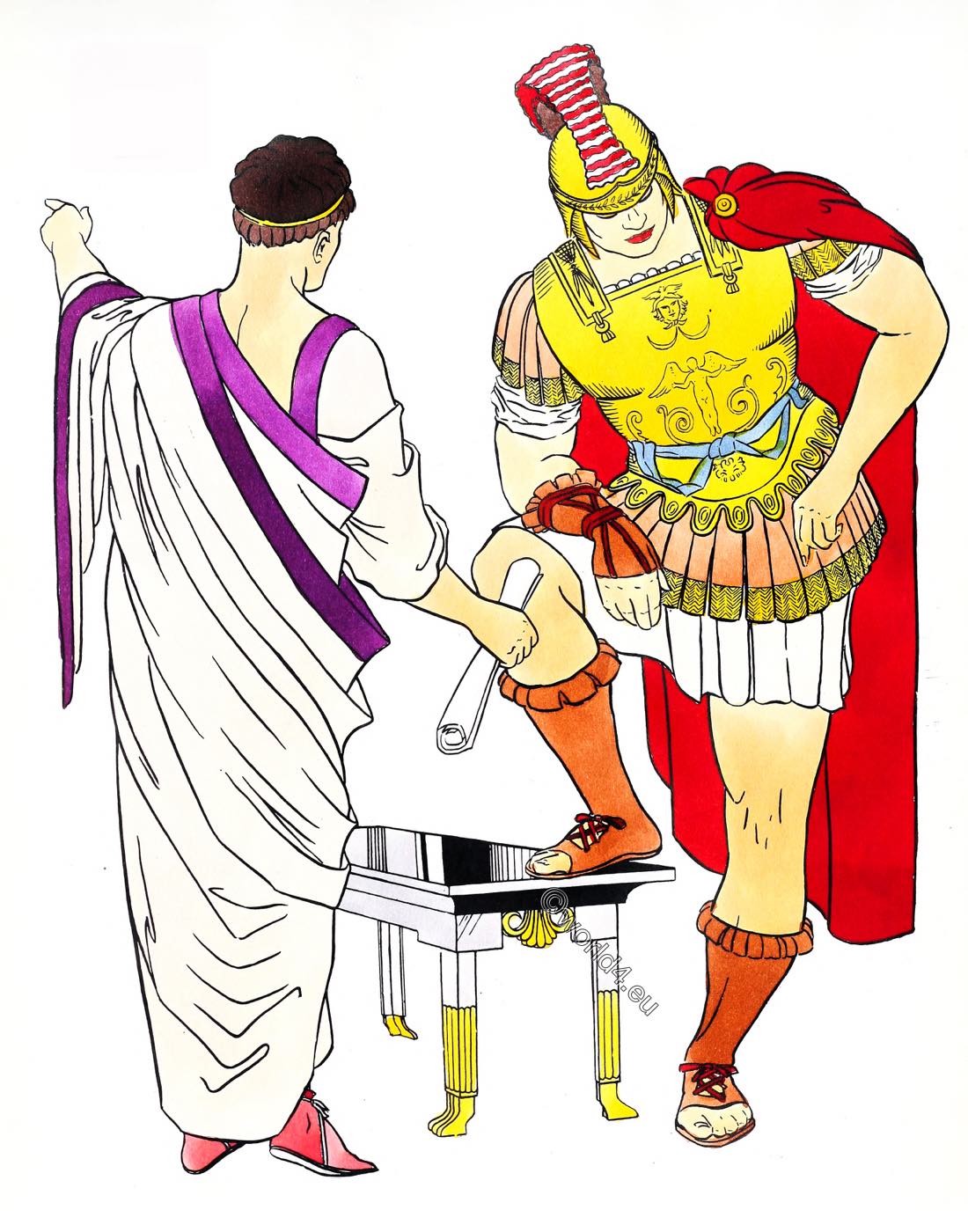The figure in the Augusteum in Dresden depicts a young Roman in the toga praetexta. At his neck he wears a bulla, a pouch consisting of a gold capsule and probably containing an amulet. Such bullae were worn by noble boys until they put on the male toga, the toga virilis or toga pura, and sometimes also by military commanders celebrating a triumph.
THE TOGA.
Roman fashion history.
A gown, the name of the principal outer garment worn by the Romans seems to have been received by them from the Etruscans. The toga was the peculiar distinction of the Romans, who were thence called togati or gens togata. (Virg. Aen. i. 282 ; Martial, xiv. 124.) It was originally worn only in Rome itself and the use of it was forbidden alike to exiles and to foreigners. (Plin. Epist. iv. 11 ; Suet. Claud. 15.) Gradually, however, it went out of common use, and was supplanted by the pallium and lacerna, or else it was worn in public under the lacerna. (Suet. Aug. 40.) [lacerna.] But it was still used by the upper classes, who regarded it as an honourable distinction (Cic. Philip, ii. 30), in the courts of justice, by clients when they received the SPORTULA (Martial, xiv. 125), and in the theatre or at the games, at least when the emperor was present. Under Alexander Severus guests at the emperor’s table were expected to appear in the toga. (Lamprid. Sever. 1.)
The exact form of the toga, and the manner of wearing it, have occasioned much dispute; but the following account, for which the writer is indebted to his friend Mr. George Scharf, jun., will set these matters in a clearer light than has hitherto been the case. The complete arrangement of this dress may be seen in many antique statues, but especially in that of Didius Julianus in the louvre, and a bronze figure of the elder Drusus discovered at Herculaneum. (See figs. 2, 3.)
The letters upon particular parts of the illustrations correspond with each other, and refer to the same places upon the general form of the toga given aboye. The method of adjusting the toga is simply this: the straigt edge (a b g d) being kept towards the neck, and the rounded towards the hand, the first part of the toga hangs in front over the left shoulder to the ground (a, fig. 4), so as to cover that entire half of the figure viewed in front.
The remainder falling behind is wrapped round the body, being carried under the right arm, and brought upwards, like a belt, across the chest, covering the left arm and shoulder for second time. It again falls behind, and terminates in the point d (fig.3), somewhat higher than the front portion (a). So far any mantle of sufficient length might be folded, but two distinctive features of Roman dress, the umbo (f) and the sinus (c e), have yet to be considered. The sinus (c e) is that upper hanging portion with the curved edge downwards which shows conspicuously upon brought round to the front of the right leg, it has atteined its greatest wit (e c e), although on therefore folded over at top, the upper part falling forward, down almost to the knee.
It may be easily raised (see fig. 5) and used as a lap-hence the name sinus to carry fruits and flowers, so often represented in ancient art. The fold at c thus becomes the upper edge, and forms the ballets, which may be made still more effective by being rolled round and slightly twisted, as in figs. 2 and 5. A variety again was sometimes produced by lifting the hanging edge (e) of this sinus up on to the shoulder, so as to cover the right arm with that alone, and Quintilian hints that it is not ungraceful to throw back the extreme edge of that again, an effect still to be admired in some of the ancient sculptures. Fig. 5. is in the act of raising the edge. The umbo (f), a projecting mass of folds in front of the body, like the boss of a shield, was formed after the rest of the dress had been put on in a very simple manner: a part of the front upright line (a b), almost covered up by the adjustment of the upper shoulder porting (g), was pulled out and made to hang down over the balteus or belt-like part (fig. 6). It is clearly traceable in both statues here given (figs. 2 and 3), and fig. 4 is intended to show the formation of the umbo more clearly by the right hand holding the edge, witch falls over the fingers instead of the ballets. In proportion as the umbo (f) projects, so of course the end (a) is raised from the ground. The smaller figures (4 and 5) are both drawn without under-garments in order to avoid confusion. During sacrifice, when necessary to cover the head, the edge (b) nearest the neck was pulled up and made to cover the head, as in fig.3, where the entire length of the edge, passing from umbo into the sinus, is very clearly visible. The dress here is very ample, and can spare an extra length, but in the statue of a priest in the Louvre the head is covered at the expense of the umbo, which has entirely disappered. Fig. 6 is intended to show the interlacing and arrangement of the toga by following the course of the straight edge alone from a to d, In many ancient statues the sleeves and folds of the tunic, being very full, are apt to be confounded with the rest, but in the best style of art this is not the case.
Quintilian cautions his orators against these incumbrances. A difference in size and fulness of the toga, modified according to the rank of the wearer, may be detected in coins and sculpture, but in all cases the mode of adjustment appears to be the same. One mode of wearing the toga was the Cinctus Gahinus. It consisted in forming a part of the toga itself into a girdle, by drawing its outer edge round the body and tying it in a knot in front, and at the same time covering the head with another portion of the garment. It was worn by persons offering sacrifices, by the consul when he declared war, and by devoted persons, as in the case of Decius. Its origin was Etruscan, as its name implies. Persons wearing this dress were said to be – precinct (or incincti) cinctu (or rite) Gabino. The color of the toga worn by men (toga virile) was generally white, that is, the natural color of white wool. Hence it was called – pura or vestimentum purum, in opposition to the pretexta mentioned below.
A brighter white was given to the toga of candidates for offices (candidate from their toga candida) by rubbing it with chalk. There is an allusion to this custom in the phrase cretata ambitio. White togas are often mentioned us worn at festivals, which does not imply that they were not worn commonly, but that new or fresh cleaned togas were first put on at festivals. The toga was kept white and clean by the fuller. When this was neglected, the toga was called sordid, and those who wore such garments Sordidati. This dress (with disarranged hair and other marks of disorder about the person) was worn by accused persons, as in the case of Cicero.
The toga pulla, which was of the natural color of black wool, was worn in private mourning, and sometimes also by artificers and others of lower orders. The toga picta, which was ornamented with Phrygian embroidery, was worn by generals in triumphs (Triumphus), and under the emperors by the consuls, and by the praetors when they celebrated the games. It was also called Capitolina. The toga palmata was a kind of toga picta.
The toga praetexta (see picture at the top) had a broad purple border. It was worn with the BULLA, by children of both sexes. It was also worn by magistrates, both those of Rome, and those of the colonies and municipia; by the sacerdotes, and by persons engaged in sacred rites or paying vows. Among those who possessed the jus togae praetextae habendae, the following may be more particulary mentioned: the dictator, the consuls, the praetors (who laid aside the praetexta when about to condemn a Roman citizen to death), the augurs (who, however, are supposed by some to have worn the trabea), the decemviri sacris faciundis, the aediles, the triumviri epulones, the senators on festival days, the magistri collegii, and the magistri vicorum when celebrating games. In the case of tribuni plebis, censors, and quaestors, there is some doupt upon the subject. The toga praetexta is said to have been derived from the Etruscans, and to have been first adopted, with the latus clavus (CLAVUS LATUS), by Tullus Hostilius as the royal robe, whence its use by the magistrates in the republic. The toga praetexta and the bulla aurea were first given to boys in the case of the son of Tarquinius Priscus, who, at the age of fourteen, in the sabine war, slew an enemy with his own hand. Respecting the leaving off of the toga praetexta, and the assumption of the toga virilis.
The occasion was celebrated with great rejoicings by the friends of the youth, who attended him in a solemn procession to the Forum and Capitol. This assumption of the toga virilis was called tirocinium fori, as being the young man’s introduction to public life. Girls wore the praetexta till their marriage. The trabea was a toga ornamented with purple horizontal stripes.
There were three kinds of trabeae; one wholly of purple and white, and another of purple and saffron, wich belonged to augurs. The purple and white trabea was a royal robe, and is assigned to the Latin and early Roman kings, especially to Romulus. It was worn by the consuls in public solemnities, such as opening the temple of Janus. The equites wore it at the transvectio, and in other public solemnities. Hence the trabea is mentioned as the badge of the equestrian order. Lastly, the toga worn by the Roman emperors was wholly of purple. It appears to have been first assumed by Julius Caesar. The material of wich the toga was commonly made was wool. It was sometimes thick and sometimes thin. The former was the toga densa, piguis, or hirta. A new toga, with the nap neither worn off nor cut close, was called pexa, to which is opposed the trita or rasa, which was used as a summer dress.
The toga was originally worn by both sexes; but when the stola came to be worn by matrons, the toga was only worn by the meretrices, and by women who had been divorced on account of adultery. (STOLA) In war the toga was laid aside, and replaced by the PALUDAMENTUM and SAGUM. Hence togatus is opposed to miles.
by William Smith.
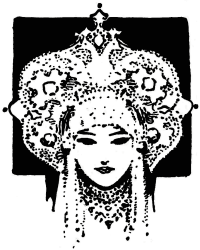
Continuing
- Roman Costume and Fashion History.
- Roman clothing in its diversity and development.
- The early toga. Former roman clothing. 700 BC. – 500 BC.
- The Toga and the manner of wearing it.
- The costume of the Roman women. Republican Rome.
- The usual Roman garment during the Republican Rome.
- Roman Republic. Senator in the toga. A commoner in the paenula.
- The Togatus and the Roman ladies of the imperial period.
- The Roman Tunica or the Dorian and the Ionian chiton.
- Musical instruments. Wind and Stringed instruments of ancient Rome.
- Roman headgear and hairdos of antiquity.
- The Roman army. The legionary soldier. Equipment, assault weapons.
- Roman soldiers and gladiators. Function, armor and armament.
- The Roman legionary. Reconstructed after reliefs of the Trajan’s Column.
- The Lictor panel. A stately Roman lictor in a rich costume.
- The Roman Paenula. The cowl or hood. Traveling cloak.
- Pontifex Maximus. Roman high priest of antiquity. Collegium Pontificum.
- An Augur. Roman official priesthood.
- Religious sacrificial ceremonies of Romans in ancient times.
- The Clothing of the Vestal Virgins. The Cult of Vesta in ancient Rome.
- Shoes of antiquity. Sandals, closed footwear of the ancient world.
- The Etruscans. Culture, costumes, warriors in Etruria.
- Greek-Roman furniture. Throne chair, Bisellium, Sella castrensis.
- Greek-Roman art. Mosaics, painted bas-reliefs and wall paintings.
- A quadriga. Greek-Roman Gods. The ancient greek-roman culture.
- The Roman Ornament. Corinthian and Composite Capitals. The Acanthus.
- Rome. The atrium. Interior of an ancient Roman palace.
- Pompeji. Roman architecture. The Pompeian House. The Atrium.





